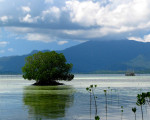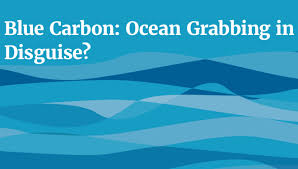Blue carbon: ecosystem services or ocean grabbing?
 Does recognising that coastal and marine ecosystems capture carbon emissions mean an economic value should be placed on them? Or will this lead to more competition to control these areas?
Does recognising that coastal and marine ecosystems capture carbon emissions mean an economic value should be placed on them? Or will this lead to more competition to control these areas?
The Blue Carbon Initiative hosted by Conservation International and IUCN defines blue carbon as “the carbon stored in coastal and marine ecosystems” such as mangroves, tidal marshes and seagrasses. It is estimated that “83% of the global carbon cycle is circulated through the ocean. Coastal habitats cover less than 20% of the total ocean area, but account for approximately half of the total carbon sequestered in ocean sediments.”
“When these ecosystems are converted or degraded, they release this stored carbon into the atmosphere and oceans and become sources of greenhouse gas (GHG) emissions. The conservation, restoration and sustainable use of these systems can support climate change, as well as conserve many other benefits these ecosystems provide, such as fisheries support and coastal protection.”
In addition coastal and marine ecosystems provide is with “with essential ecosystem services such as coastal protection from storms and nursery grounds for fish”. According to the Blue Carbon Policy Framework it is now time to “further explore how to best include the carbon value of coastal ecosystems in the accounting and payment of other ecosystem services”.
Read more
See also: The International Partnership for Blue Carbon brings together “governments, non-profit organisations, intergovernmental agencies, and scientists to increase understanding of, and accelerate action on the important role of coastal blue carbon ecosystems in climate change action.”
See also: Painting Africa’s economy blue (IIED / July 2015)
 A report by the Transnational Institute observes that “while the global rush to control land resources is well established, similar ‘power-grabs’ in relation to aquatic resources are less well-known and researched.”
A report by the Transnational Institute observes that “while the global rush to control land resources is well established, similar ‘power-grabs’ in relation to aquatic resources are less well-known and researched.”
Driving these ocean grabs are processes to place an economic value on aquatic resources and the inclusion of coastal ecosystems into carbon markets. The result is that “increasingly, conservation efforts that purportedly align the needs of the poor, profit interests and environmental concerns are one of the main processes through which ocean grabbing takes place”.
In some cases the effort to value blue carbon builds on initiatives to reduce emissions from deforestation known as REDD+(see Guidance for national blue carbon activities by the Blue Carbon Initiative). The report argues: “In tune with the logic in the already existing REDD+ mechanisms, a prerequisite for trading is putting a monetary value on coastal ecosystems. Blue carbon projects therefore aim to value these areas based on how much carbon they can capture and store and open them up for investment that – it is assumed – will ensure protection. This will in turn give the investor (e.g. governments, transnational corporations etc.) an amount of carbon credits corresponding to the stored and expected capture of carbon, which in theory ’offsets’ carbon emissions elsewhere”. See more on REDD+ here.
Read report
————————————
This summary was prepared by Why Green Economy?. The views expressed have been paraphrased. See the original source for more information.

Leave a Reply